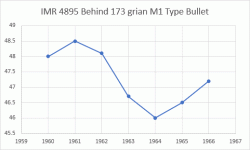Freeloader Reloader,
We never try to hit certain velocity numbers in loading for a rifle because the individual chamber and bore dimensions can cause the pressures to be unpredictable. If you get lower numbers than published, this generally means your peak pressure from a load is lower, but if you raise the charge to compensate, you will definitely be raising muzzle pressure, and with the Garand op-rod dependent on that pressure, you don't want to mess with it without some way to measure whether or not the gas cylinder is overpressurizing.
I once fired a fair amount of 1964 National Match ammunition in several club Garands with wildly different amounts of wear on them. The claimed muzzle velocity (I believe taken at 15 ft from the muzzle rather than the military's traditional 78-foot sample point) was 2669 ft/s from a 24" test barrel with tight internal dimensions and the cartridge loaded so as to ensure the powder was back over the primer vent (flash hole), which gives the greatest pressure and velocity. I got results ranging from 2494 fps to 2611 fps from the actual guns, and found an 80 fps difference in velocity depending on whether the powder was back over the primer or forward over the bullet (there was also a change in the primer, which was a bit flat when fired with the powder over the primer and with no trace of flattening when the power was forward in the case).
From those numbers, you can get some idea of what to expect from real guns vs. the test velocities published for military test barrels. Since you can't know in advance just where your gun's MV will fall inside the range, you do best to stick to published loads for the Garand.
The National Match historic load data for IMR 4895 can be averaged for use with the 175-grain Sierra MatchKing bullet. It comes out to 47.3 grains. This assumes the military lots of the powder averaged out to have the same burn rate canister grade does today. The plot below seems to show that it does. Based on Hodgdon's data for current production IMR 4895, which has a starting load of 46-grains and a maximum of 49-grains, this load should produce 2672 fps from their pressure gun's 24" barrel, at a pressure of about 54,300 psi or 45,300 CUP. You can begin with Hodgdon's 46-grain starting load, or even go as low as about 40 grains (based on 70% case fill minimum) as some of the Hornady Garand loads do. Work up in about 0.4-grain steps toward 47.3-grains, but I don't think I would go over that (no reason to) without a special gas cylinder plug that lowers pressure. During the workup, watch to see if your gun shoots any more accurately with some particular load you try on the way up. The Sierra bullet has a slightly wider meplat than the military bullet, so COL should be either Sierra's recommended 3.290" or Hodgdon's 3.300" for that MatchKing bullet. Anywhere in there will be fine.

The M1 Garand was designed to use M1 Ball ammo with that same 173-grain bullet weight because government stockpiles of it existed between the World Wars, so it is what the Army required of the Garand to be able to handle. M2 Ball with it's 150.5-grain flat base bullet was designed in 1938 and adopted in 1939. It was developed both because National Guard practice ranges did not have long enough drop zones for the more aerodynamic 173-grain M1 Ball bullet's 5500-yard extreme range, and also because soldiers practicing with the Springfield rifle complained about the recoil level of the heavier bullet load. In WWII combat, all available ammo saw use at one time or another, but the 163-168-grain armor-piercing bullet in M2 AP was issued a lot and was considered more accurate. The weight variation was due to different penetrator alloys being used at different times.
For 150-grain FMJ bullets mimicking M2 Ball, you want to be going about 125 fps faster. Interestingly enough, based on Hodgdon's data for the 150-grain Nosler BT, in their test barrel this winds up being 47.4-grains of current production IMR 4895, so it is close enough to the National Match imitating load that you could use the same powder setting to load both. It is below Hodgdon's starting load of 49.0 grains for this lighter bullet, but the case fill is over 80% so there is no hazard in that. Pressure with the 150-grain bullet should be about 46,400 psi or 38,700 CUP. Very mild. I use the Hornady 150-grain FMJ for this, as I'm not expected a ball load to be super match. The COL with it is 3.185", as determined by locating the crimp cannelure near the case mouth.

